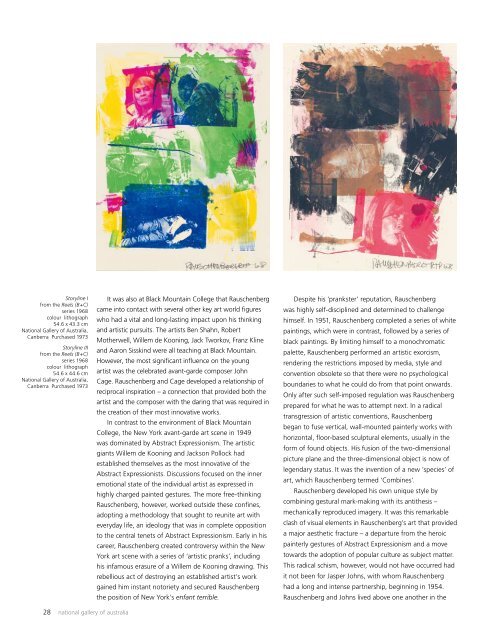Art Ew - National Gallery of Australia
Art Ew - National Gallery of Australia
Art Ew - National Gallery of Australia
You also want an ePaper? Increase the reach of your titles
YUMPU automatically turns print PDFs into web optimized ePapers that Google loves.
Storyline I<br />
from the Reels (B+C)<br />
series 1968<br />
colour lithograph<br />
54.6 x 43.3 cm<br />
<strong>National</strong> <strong>Gallery</strong> <strong>of</strong> <strong>Australia</strong>,<br />
Canberra Purchased 1973<br />
Storyline III<br />
from the Reels (B+C)<br />
series 1968<br />
colour lithograph<br />
54.6 x 44.6 cm<br />
<strong>National</strong> <strong>Gallery</strong> <strong>of</strong> <strong>Australia</strong>,<br />
Canberra Purchased 1973<br />
28 national gallery <strong>of</strong> australia<br />
It was also at Black Mountain College that Rauschenberg<br />
came into contact with several other key art world figures<br />
who had a vital and long-lasting impact upon his thinking<br />
and artistic pursuits. The artists Ben Shahn, Robert<br />
Motherwell, Willem de Kooning, Jack Tworkov, Franz Kline<br />
and Aaron Sisskind were all teaching at Black Mountain.<br />
However, the most significant influence on the young<br />
artist was the celebrated avant-garde composer John<br />
Cage. Rauschenberg and Cage developed a relationship <strong>of</strong><br />
reciprocal inspiration – a connection that provided both the<br />
artist and the composer with the daring that was required in<br />
the creation <strong>of</strong> their most innovative works.<br />
In contrast to the environment <strong>of</strong> Black Mountain<br />
College, the New York avant-garde art scene in 1949<br />
was dominated by Abstract Expressionism. The artistic<br />
giants Willem de Kooning and Jackson Pollock had<br />
established themselves as the most innovative <strong>of</strong> the<br />
Abstract Expressionists. Discussions focused on the inner<br />
emotional state <strong>of</strong> the individual artist as expressed in<br />
highly charged painted gestures. The more free-thinking<br />
Rauschenberg, however, worked outside these confines,<br />
adopting a methodology that sought to reunite art with<br />
everyday life, an ideology that was in complete opposition<br />
to the central tenets <strong>of</strong> Abstract Expressionism. Early in his<br />
career, Rauschenberg created controversy within the New<br />
York art scene with a series <strong>of</strong> ‘artistic pranks’, including<br />
his infamous erasure <strong>of</strong> a Willem de Kooning drawing. This<br />
rebellious act <strong>of</strong> destroying an established artist’s work<br />
gained him instant notoriety and secured Rauschenberg<br />
the position <strong>of</strong> New York’s enfant terrible.<br />
Despite his ‘prankster’ reputation, Rauschenberg<br />
was highly self-disciplined and determined to challenge<br />
himself. In 1951, Rauschenberg completed a series <strong>of</strong> white<br />
paintings, which were in contrast, followed by a series <strong>of</strong><br />
black paintings. By limiting himself to a monochromatic<br />
palette, Rauschenberg performed an artistic exorcism,<br />
rendering the restrictions imposed by media, style and<br />
convention obsolete so that there were no psychological<br />
boundaries to what he could do from that point onwards.<br />
Only after such self-imposed regulation was Rauschenberg<br />
prepared for what he was to attempt next. In a radical<br />
transgression <strong>of</strong> artistic conventions, Rauschenberg<br />
began to fuse vertical, wall-mounted painterly works with<br />
horizontal, floor-based sculptural elements, usually in the<br />
form <strong>of</strong> found objects. His fusion <strong>of</strong> the two-dimensional<br />
picture plane and the three-dimensional object is now <strong>of</strong><br />
legendary status. It was the invention <strong>of</strong> a new ‘species’ <strong>of</strong><br />
art, which Rauschenberg termed ‘Combines’.<br />
Rauschenberg developed his own unique style by<br />
combining gestural mark-making with its antithesis –<br />
mechanically reproduced imagery. It was this remarkable<br />
clash <strong>of</strong> visual elements in Rauschenberg’s art that provided<br />
a major aesthetic fracture – a departure from the heroic<br />
painterly gestures <strong>of</strong> Abstract Expressionism and a move<br />
towards the adoption <strong>of</strong> popular culture as subject matter.<br />
This radical schism, however, would not have occurred had<br />
it not been for Jasper Johns, with whom Rauschenberg<br />
had a long and intense partnership, beginning in 1954.<br />
Rauschenberg and Johns lived above one another in the

















